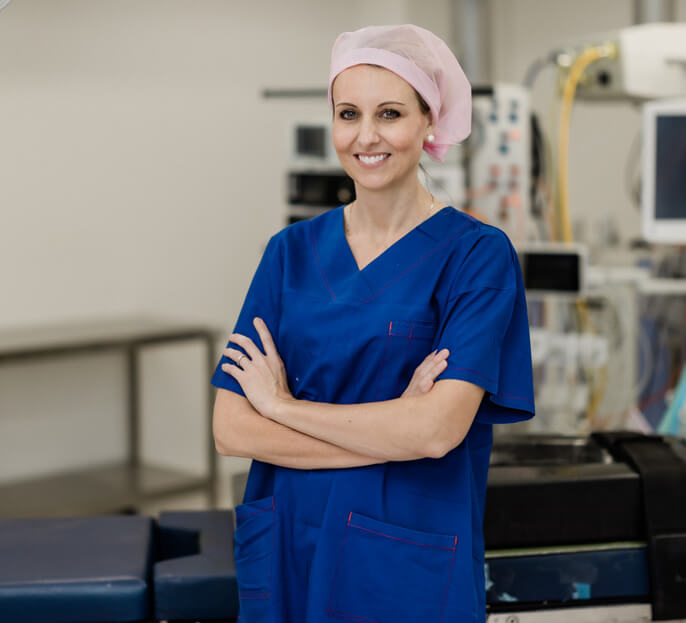How Laparoscopic Surgery Helps Treat Gynaecological Conditions
For many women, surgery may be recommended to diagnose or treat conditions such as endometriosis, fibroids, ovarian cysts, or pelvic organ prolapse. The good news is that surgery today is far less invasive than it was in the past. Thanks to modern techniques like laparoscopic and robotic gynaecology surgery, women can recover faster, experience reduced pain, and return to normal activities sooner.
At her clinic in Gosford, Dr Kelly Hankins offers advanced minimally invasive gynaecology surgery to help women regain their health and quality of life. In this article, we explore how laparoscopic surgery works, what conditions it can treat, and when it might be the right option for you.

What Is Laparoscopic Surgery?
Laparoscopic surgery, sometimes referred to as “keyhole surgery”, is a minimally invasive surgical technique used to examine and operate on structures inside the abdomen and pelvis.
Rather than making a large incision, the surgeon uses:
- A few small cuts, usually 0.5 to 1cm
- A tiny camera (laparoscope) to view the organs
- Fine surgical instruments to perform the procedure
For complex cases, robotic-assisted laparoscopic surgery can offer even greater precision and control.
Conditions Treated with Laparoscopic or Robotic Surgery
Laparoscopic techniques are commonly used to diagnose and treat a wide range of gynaecological conditions, including:
- Endometriosis
Laparoscopy allows for the direct visualisation and removal of endometrial lesions, making it a preferred technique for diagnosis and treatment. Many patients experience significant pain relief and improved fertility after surgery.
- Ovarian Cysts
Most cysts are benign, but large or persistent ones may need removal. Laparoscopic cystectomy allows precise removal while preserving healthy ovarian tissue.
- Fibroids
Fibroids can cause heavy bleeding, pelvic pain, and pressure. Laparoscopic myomectomy or hysterectomy may offer effective treatment, with some patients experiencing quicker recovery when compared to open surgery.
- Pelvic Organ Prolapse
In cases of uterine or vaginal wall prolapse, prolapse surgery can be performed laparoscopically or robotically and may provide improved anatomical support and comfort.
- Hysterectomy
For patients needing a hysterectomy, laparoscopic or robotic techniques may reduce hospital stay and minimise discomfort.
Benefits of Laparoscopic and Robotic Gynaecology Surgery
Minimally invasive surgery can offer several advantages compared to traditional open surgery:
- Smaller incisions and minimal scarring
- Possibility of less pain after surgery
- Reduced risk of infection or complications
- Shorter hospital stays, often same-day or overnight
- Possible faster recovery and return to daily life
- Greater precision and visibility during surgery
Dr Kelly Hankins is qualified in both standard laparoscopic and robotic gynaecology surgery, allowing her to tailor each procedure to the patient’s needs.
Is Robotic Surgery Safe?
Yes. Robotic-assisted surgery is safe and effective when performed by trained and qualified specialists. The surgeon remains in complete control of the robotic arms, which provide enhanced dexterity and 3D visualisation, especially useful for delicate or deep pelvic procedures, such as severe endometriosis.
What to Expect Before and After Surgery
Before surgery, Dr Hankins will:
- Review your medical history
- Explain the procedure and risks
- Provide instructions for pre-op preparation
- Answer any cost-related questions
After surgery:
- Most patients can return home within 24 hours
- Discomfort is usually mild and manageable with pain relief
- Full recovery typically takes 1-2 weeks for simple procedures, and up to 4-6 weeks for complex surgeries
You’ll receive personalised follow-up care to ensure everything is healing as expected.
When to Consider Surgery
Not all gynaecological issues require surgery. But if you’ve tried medical management without success, or your symptoms are affecting your quality of life, it may be time to explore surgical options.
You might benefit from laparoscopic surgery if you:
- Have persistent pelvic pain
- Experience heavy or irregular bleeding
- Have a known gynaecological condition like fibroids, endometriosis, or cysts
- Are planning a hysterectomy or prolapse repair
- Want a definitive diagnosis for unexplained symptoms
Costs and Insurance Coverage
Most gynaecology surgeries are eligible for Medicare rebates, and many private health funds provide partial or full coverage for hospital and theatre fees. Our team will provide a detailed cost outline before your procedure so you can make informed choices.
Why Choose Dr Kelly Hankins?
As a leading female Gynaecologist in Gosford, Dr Kelly Hankins is committed to delivering safe, modern surgical care that’s personalised to your needs. With her expertise in minimally invasive and robotic techniques, she provides qualified care with fewer disruptions to your life.
Next Steps
Laparoscopic and robotic surgery can offer women a faster, gentler path to recovery from many common gynaecological conditions. If you’ve been living with symptoms that limit your comfort, health, or fertility, it may be time to explore your options.
Medical Disclaimer
This article is for general information and educational purposes only. It is not a substitute for professional medical advice, diagnosis, or treatment, and does not establish a doctor-patient relationship. All medical procedures carry risks, and outcomes vary between individuals. Always seek the advice of your GP, specialist, or another appropriately qualified health professional with any questions you may have regarding a medical condition or treatment. Where further or specialised care is required, your treating practitioner can provide an appropriate referral.